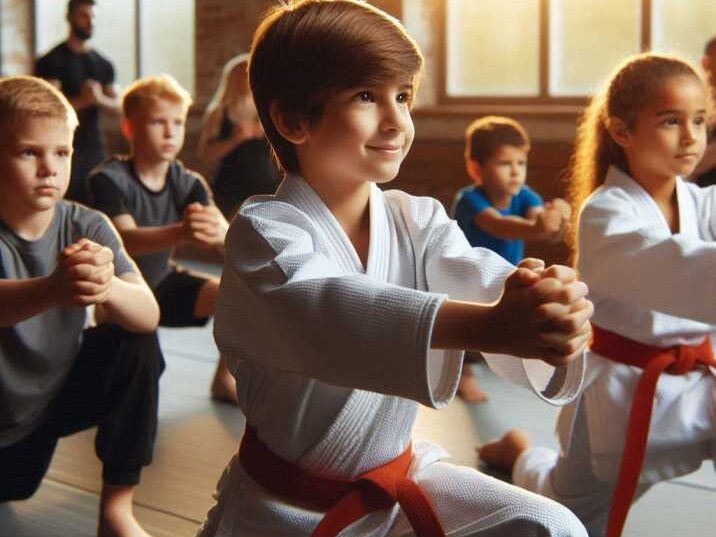Introduction
Table of Contents
Mixed Martial Arts (MMA) is not just about fighting—it’s a great way for kids to stay fit, learn self-discipline, and improve their focus in school and other activities. Training in MMA requires concentration and discipline, which can help kids stay more focused in all areas of their lives. In this article, we will explore a mixed martial arts workout routine designed for kids. These exercises are fun, safe, and perfect for developing both physical strength and mental toughness.

What is Mixed Martial Arts (MMA)?
Mixed Martial Arts, or MMA, is a combat sport that combines various techniques from different martial arts disciplines, including boxing, jiu-jitsu, karate, Muay Thai, and wrestling. It focuses on both stand-up fighting and ground combat, making it a versatile and complete form of martial art. For kids, MMA is not just about learning how to fight but also about building confidence, respect, and self-control.
Benefits of Mixed Martial Arts Workout for Kids
1. Improves Physical Fitness:
Mixed Martial Arts workouts are a fantastic way for kids to stay active and healthy. These workouts involve a variety of exercises, such as running, jumping, punching, kicking, and grappling, which help improve cardiovascular health by getting the heart pumping and increasing endurance. MMA also builds strength through bodyweight exercises like push-ups and squats, enhances agility with fast-paced movements and footwork drills, and improves flexibility through stretching and dynamic movements. This comprehensive approach ensures that kids develop all-around fitness, which is crucial for their overall physical development.
2. Enhances Focus and Discipline:
MMA training takes place in a structured environment where kids are required to follow instructions, listen attentively, and practice self-control. During a typical class, kids must focus on learning new techniques, practicing combinations, and refining their movements. This structured approach teaches them to concentrate on the task at hand, which directly translates to improved focus in school. By learning to stay disciplined in MMA training—showing up regularly, working hard, and paying attention—kids also develop the mental skills needed to succeed academically and in other areas of their lives
3. Builds Self-Confidence:
Participating in MMA helps kids gain self-confidence as they learn and master new techniques. The sense of accomplishment that comes from progressing through the different skill levels, such as earning a new belt or successfully performing a difficult move, boosts their self-esteem. This newfound confidence doesn’t just stay on the mat; it carries over into other areas of their lives, such as speaking up in class, trying new activities, or making new friends. Knowing they have the skills to defend themselves if necessary also adds to their sense of security and self-worth.
4. Teaches Respect and Sportsmanship:
MMA emphasizes the importance of respect—for trainers, peers, and opponents. Kids learn to bow or shake hands before and after sparring, showing respect for their partner. They are taught to value their coaches’ knowledge and experience, listen to instructions carefully, and thank their training partners after practice. This culture of respect teaches valuable lessons in humility, understanding that there is always something to learn from others, and good sportsmanship, where winning and losing are both seen as opportunities for growth
5. Promotes Healthy Lifestyle:
Regular MMA training encourages kids to adopt a healthy lifestyle. Because MMA is a demanding sport, it requires kids to stay properly nourished and hydrated to perform at their best. Coaches often educate kids about the importance of eating balanced meals rich in protein, vitamins, and minerals to fuel their bodies. They also emphasize the importance of drinking plenty of water, especially during intense workouts, to stay hydrated. Additionally, kids learn about the importance of rest and recovery, understanding that proper sleep is essential for muscle recovery and overall health. These habits, cultivated from a young age, help kids develop a healthy lifestyle that can benefit them throughout their lives.
Essential Components of an Mixed Martial Arts Workout Routine
An effective MMA workout routine for kids should include several key components to ensure a well-rounded development. Let’s dive into these components:
1. Warm-Up Exercises for MMA
Warm-up exercises are essential for preparing the body for more intense physical activity and reducing the risk of injury. A good warm-up increases blood flow to the muscles, improves flexibility, and gets the body ready for the demands of a workout.
Jumping Jacks:
Jumping jacks are a great way to get the heart rate up and increase overall body warmth. Performing 2 sets of 20 repetitions engages multiple muscle groups, including the legs, arms, and core, which helps to boost cardiovascular fitness and muscle activation. This exercise prepares the body for more strenuous activity by increasing circulation and flexibility.
Arm Circles:
Arm circles involve extending the arms out to the sides and making circular motions, both forward and backward. Doing 2 sets of 10 repetitions in each direction helps warm up the shoulders and arms, improving joint mobility and reducing stiffness. This exercise is crucial for preventing shoulder injuries and enhancing upper body range of motion.
High Knees:
High knees involve running in place while lifting the knees as high as possible. Performing 2 sets of 15 repetitions helps elevate the heart rate and warm up the legs and core. This exercise improves coordination, agility, and leg strength, preparing the body for the dynamic movements involved in MMA.
Dynamic Stretching:
Dynamic stretching involves moving the body through a full range of motion, targeting all major muscle groups. Spending 5 minutes on dynamic stretches helps increase muscle flexibility, joint mobility, and blood flow. It prepares the muscles for the demands of the workout by enhancing their elasticity and reducing the risk of injury. Dynamic stretches might include leg swings, arm swings, and torso twists.
2. Strength Training for Kids in MMA
Strength training is crucial in Mixed Martial Arts (MMA) as it helps build muscle endurance and power, both of which are essential for effective performance. For kids, bodyweight exercises are ideal for developing foundational strength without the need for heavy weights.
Push-Ups:
Push-ups are a classic exercise that targets the chest, shoulders, and triceps. By performing 3 sets of 10 repetitions, kids can build upper body strength and improve their ability to push and strike effectively in MMA. This exercise also helps stabilize the core.
Squats:
Squats work the legs, particularly the quadriceps, hamstrings, and glutes. Doing 3 sets of 15 repetitions helps improve lower body strength, which is vital for powerful kicks and maintaining a strong stance. Squats also enhance overall balance and coordination.
Plank Holds:
The plank is an excellent exercise for strengthening the core, which includes the abdominals and lower back. Holding a plank for 3 sets of 20 seconds helps improve core stability, crucial for maintaining balance and proper posture during MMA movements.
Superman Exercise:
The Superman exercise targets the lower back, glutes, and shoulders. By lifting both arms and legs while lying face down and holding for a few seconds, kids can build lower back strength and stability, which supports better performance in grappling and other MMA techniques. Doing 3 sets of 10 repetitions enhances overall back strength and endurance.

3. Skill Drills for Mixed Martial Arts workouts
Skill drills are designed to enhance specific MMA techniques like striking, kicking, and grappling, and also improve coordination and balance. These drills help kids practice and perfect their movements, which is crucial for their overall development in the sport.
Shadow Boxing:
Shadow boxing involves practicing punches, combinations, and footwork without a partner. Performing 3 sets of 1 minute each helps kids work on their striking techniques, improve their footwork, and develop better timing and movement. It’s a great way for kids to visualize and refine their techniques.
Focus Mitt Drills:
Focus mitt drills are conducted with a partner holding mitts to target punches and combinations. Doing 3 sets of 1 minute helps kids practice their accuracy, speed, and power. These drills also improve hand-eye coordination and help kids learn to react to different scenarios.
Kicking Drills:
Kicking drills involve performing various kicks, such as front kicks, roundhouse kicks, and side kicks. Performing 3 sets of 10 kicks per leg helps develop leg strength, balance, and technique. Consistent practice improves the effectiveness and precision of kicks in real sparring situations.
Grappling Practice:
Grappling drills involve practicing holds, takedowns, and submissions with a partner. Performing 3 sets of 1 minute helps kids learn and refine their grappling techniques, improve strength, and develop tactical skills. These drills are essential for mastering close-quarters combat.
4. Cardiovascular Conditioning for MMA
Cardiovascular conditioning is essential for improving stamina and endurance, which are crucial in MMA. These exercises help kids build their aerobic capacity and overall fitness in a fun and engaging way.
Jump Rope:
Jump rope exercises are excellent for improving cardiovascular fitness and footwork. Doing 3 sets of 2 minutes helps increase agility, coordination, and endurance. It’s a great way to get the heart rate up while enhancing overall fitness.
Burpees:
Burpees are a full-body exercise that combines a squat, push-up, and jump. Performing 3 sets of 10 repetitions helps improve cardiovascular conditioning, strength, and explosiveness. They are effective for building endurance and enhancing overall fitness.
Sprints:
Sprints involve running short distances at high speed. Doing 3 sets of 20 meters helps develop speed, power, and cardiovascular endurance. This exercise mimics the bursts of energy needed in Mixed Martial Arts workouts and helps improve quickness and agility.
Agility Ladder Drills:
Agility ladder drills involve quick, precise footwork through a ladder laid on the ground. Performing 3 sets of 1 minute helps improve agility, foot speed, and coordination. These drills enhance a kid’s ability to move quickly and efficiently in the ring.
5. Cool-Down and Stretching
Cool-down and stretching are important for recovery and injury prevention. They help the body transition from intense activity to a resting state and maintain flexibility.
Static Stretching:
Static stretching involves holding stretches for 20-30 seconds to improve flexibility and muscle recovery. Spending 5 minutes focusing on all major muscle groups helps reduce muscle soreness and maintain a good range of motion.
Breathing Exercises:
Breathing exercises involve deep, controlled breaths to help the body and mind relax after a workout. Spending 2 minutes on these exercises helps calm the mind, reduce stress, and improve overall relaxation, which is important for recovery and mental well-being.
Mixed Martial Arts Training Tips for Kids
1. Stay Hydrated:
It’s important for kids to drink plenty of water before, during, and after their mixed martial arts workouts. Staying hydrated helps maintain energy levels, prevents cramps, and ensures their body functions properly during physical activities. Dehydration can lead to fatigue and reduce performance, so kids should always keep a water bottle handy.
2. Wear Proper Gear:
Using the right protective gear is essential to prevent injuries during training. Gloves protect the hands and wrists when punching, shin guards protect the legs during kicks, and headgear shields the head from impact. Wearing the proper gear helps kids train safely and confidently.
3. Listen to Coaches:
Following the instructions given by the coach is crucial for learning MMA techniques correctly and safely. Coaches provide valuable guidance on form and strategy, ensuring kids develop good habits and avoid mistakes that could lead to injuries. Listening attentively also helps kids improve faster.
4. Practice Consistently:
Regular practice is the key to mastering MMA techniques and improving overall fitness levels. Consistency helps kids build muscle memory, making movements more natural and efficient over time. Frequent training also helps them stay in shape and continuously improve their skills.
5. Maintain a Healthy Diet:
Eating a balanced diet rich in proteins, vitamins, and minerals is important for muscle recovery and overall growth. A healthy diet provides the necessary nutrients for energy and helps the body repair itself after tough workouts. Kids should focus on eating a variety of foods to ensure they get all the nutrients they need.
Creating a Safe and Fun MMA Environment for Kids
To ensure that kids enjoy Mixed Martial Arts Training and stay safe while training, it’s important to create a positive environment. Coaches and parents should encourage kids, celebrate their progress, and emphasize the importance of teamwork and respect.
Table of Information: Sample Mixed Martial Arts Workout Routine
| Exercise | Type | Repetitions/Sets | Duration |
|---|---|---|---|
| Jumping Jacks | Warm-Up | 2 sets of 20 reps | 2 minutes |
| Push-Ups | Strength Training | 3 sets of 10 reps | 3 minutes |
| Shadow Boxing | Skill Drill | 3 sets of 1 minute | 3 minutes |
| Jump Rope | Cardio | 3 sets of 2 minutes | 6 minutes |
| Static Stretching | Cool-Down | 5 minutes | 5 minutes |
Conclusion
Mixed Martial Arts is an excellent workout routine for kids that promotes physical fitness, mental focus, and self-discipline. By incorporating a well-rounded Mixed Martial Arts workout into their daily routine, kids can enjoy the benefits of a healthier lifestyle while learning valuable life skills. Whether it’s for building strength, learning self-defense, or just having fun, MMA offers something for every young athlete.
FAQs
- What age is appropriate for kids to start MMA?
- Kids can start learning MMA from around 5-6 years old, focusing on basic techniques and exercises.
- Can MMA training help with school performance?
- Yes, the focus and discipline learned in MMA can translate to better concentration and performance in school.
- Is Mixed Martial Arts training safe for children?
- Yes, with proper supervision, protective gear, and age-appropriate exercises, Mixed Martial Arts training is safe for children.
- How often should kids practice MMA?
- Kids can practice MMA 2-3 times a week to balance training with rest and recovery.
- Do kids need special equipment for Mixed Martial Arts training?
- Basic equipment includes gloves, shin guards, and headgear to ensure safety during training.


